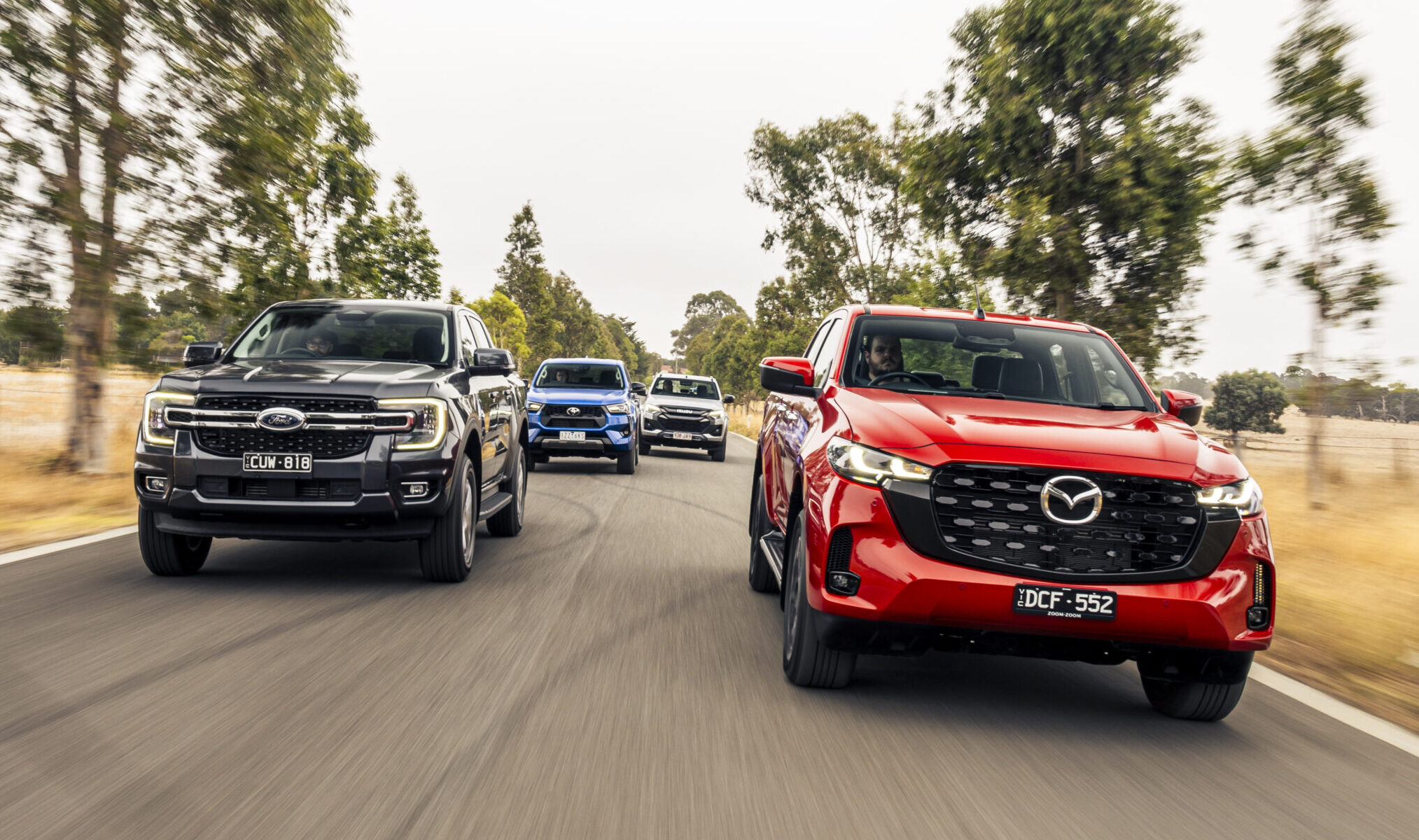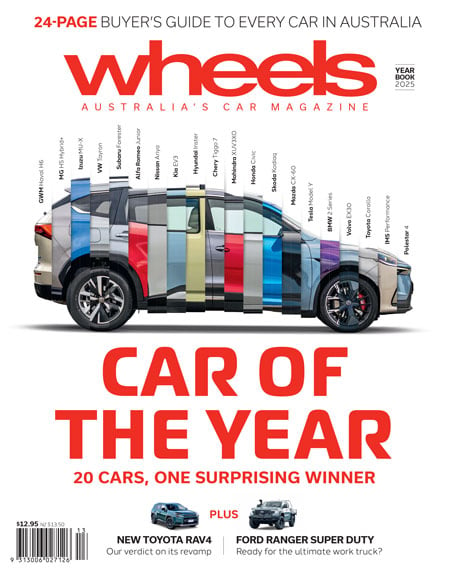Welcome to the new Ford Falcon versus Holden Commodore. Both those cars, which filled so many pages of Wheels, are now obviously gone, left to haunt places like the eerily quiet high-speed bowl of the old Holden Lang Lang Proving Ground… or, dare we say, your local taxi rank. However you want to remember the old Aussie sedans, there’s no escaping the fact they were the nation’s top-selling vehicles. For decades.
But there is nothing permanent except change, and a quarter of the way into this century, the old Falcon and Commodore sales race has morphed into this: a fierce battle between dual-cab utes. As hotly contested now as it was then between the old rear-drive four-doors, three of the top four selling vehicles in Australia in 2024 were dual-cab utes. And today, in a sunny carpark in the tiny town of Clarkefield just north of Melbourne, we’re seeing how they compare.

Hitting bitumen and gravel roads in Victoria to see if the existing front-runners are still worthy of their best-seller status, leading our contenders for this test is Ford’s best-selling Ranger – Australia’s most popular new vehicle. If the Australian sales race was an actual championship, the Ford Ranger would wear the number ‘1’ loud and proud on its side.
In 2024, the Ford Ranger topped the local new car sales charts with 62,593 examples sold, ahead of the Toyota RAV4 – followed by the third-placed Toyota HiLux on 53,499 sales, and then the fourth-placed Isuzu D-Max with 30,194 units sold.
As close a spiritual successor to the Falcon as you could hope, many of the Ranger’s designers and engineers are the same people who worked on generations of Ford’s much-loved four-door. The Ranger was also developed at Ford’s You Yangs Proving Ground west of Melbourne and on many of the same roads as Falcon and Territory before it. If a Falcon ute pinched the metamorphic pills of a Marvel superhero and swallowed them all at once, you’d basically just have a Ranger.
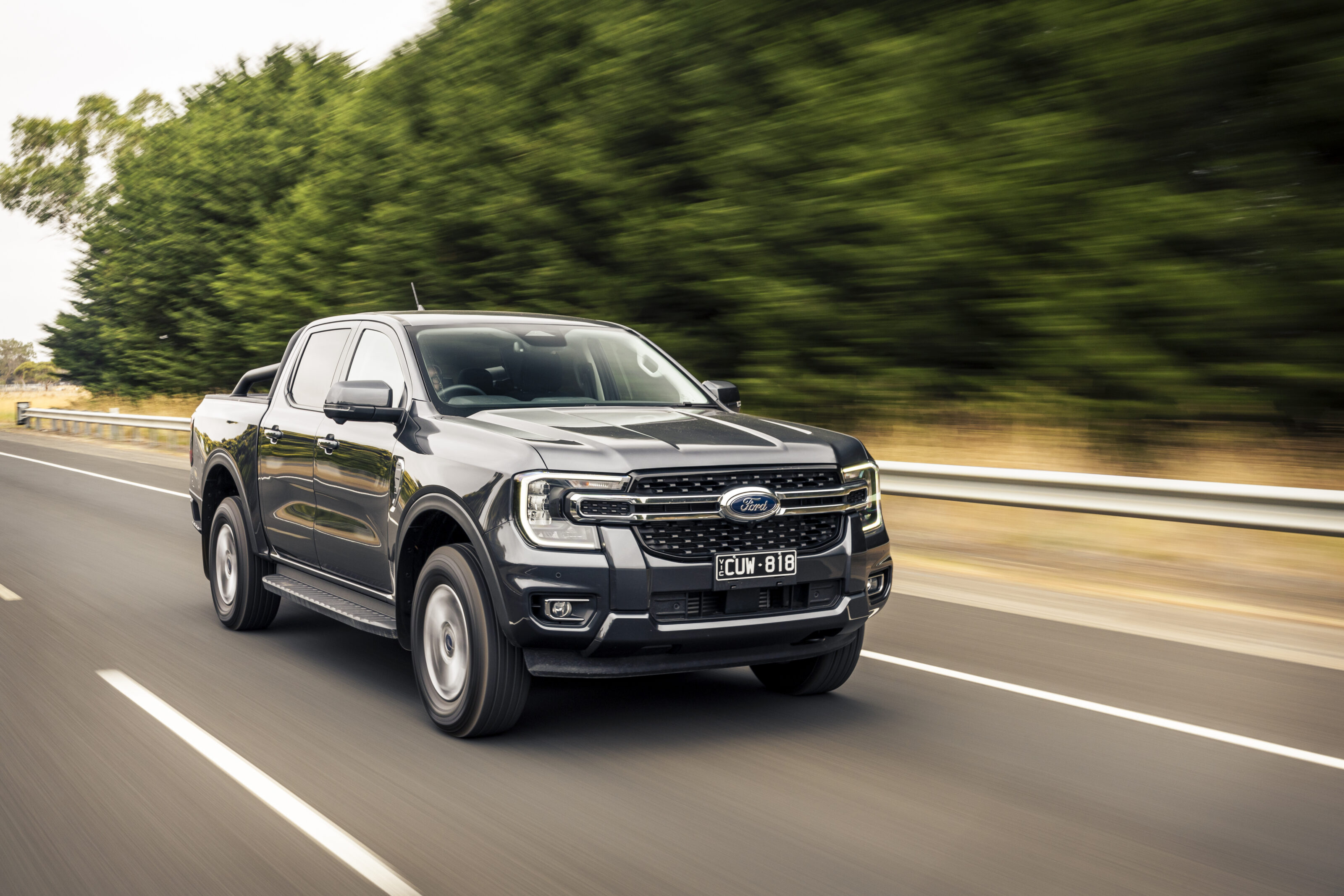
Of course, Ford also effectively moved its factory from Broadmeadows to Thailand, but given its locally-developed DNA, there is something just right about the Ranger being Australia’s most popular vehicle.
Akin to the Holden Commodore, although only in a sales sense, is the evergreen Toyota HiLux. Built like a cast iron griddle, the HiLux was Australia’s new car sales champion seven years on the trot from 2016 to 2022, before being usurped by the Ranger – and, more recently, the RAV4.
Much like that car, the HiLux is now a hybrid – although a much milder one. With a 48-volt architecture, the recently revised HiLux now bolts a motor-generator to its 1GD 2.8-litre turbodiesel four-cylinder, the motor-generator mounted high in the engine bay to keep it dry during water crossings, or so says Toyota.
The unit itself produces 8.4kW/65Nm and is paired with a 48-volt battery, able to scavenge energy under braking and redeploy it – such as in enabling long periods of engine-off time, in traffic – with its start-stop system. The 48-volt HiLux idles at just 600rpm and Toyota claims the system saves around nine per cent fuel. With the New Vehicle Efficiency Standard (NVES) now looming large over the Australian new car market like a storm cloud, every drop of fuel saved will count.

There’s no shortage of competitors keeping Ranger and HiLux on their all-terrain toes and the parched, thirsty, straw-coloured hills of today’s ute shootout testify to a lack of rain around Melbourne in recent months – but it is raining dual-cab rivals.
While BYD has launched a Shark 6 attack against Ranger and HiLux with its superbly priced hybrid ute, and other newer Chinese manufacturers such as JAC and GWM pile on the pressure, the Australian ute buyer still prefers products from established brands for now. Brands like Isuzu and Mazda.
Powered by the venerable 3.0-litre 4JJ3-TCX four-cylinder turbodiesel, and with a six-speed auto, Isuzu’s D-Max has earned a reputation for reliability as if the engine itself is ready to become a sealed unit.
Coupled with value, the D-Max is one of the surprise performers on the Aussie sales charts at present, and was Australia’s fourth best-selling vehicle in 2024. It’s fresh from a facelift last year which saw revised exterior styling and a new infotainment system, along with additional active safety features.
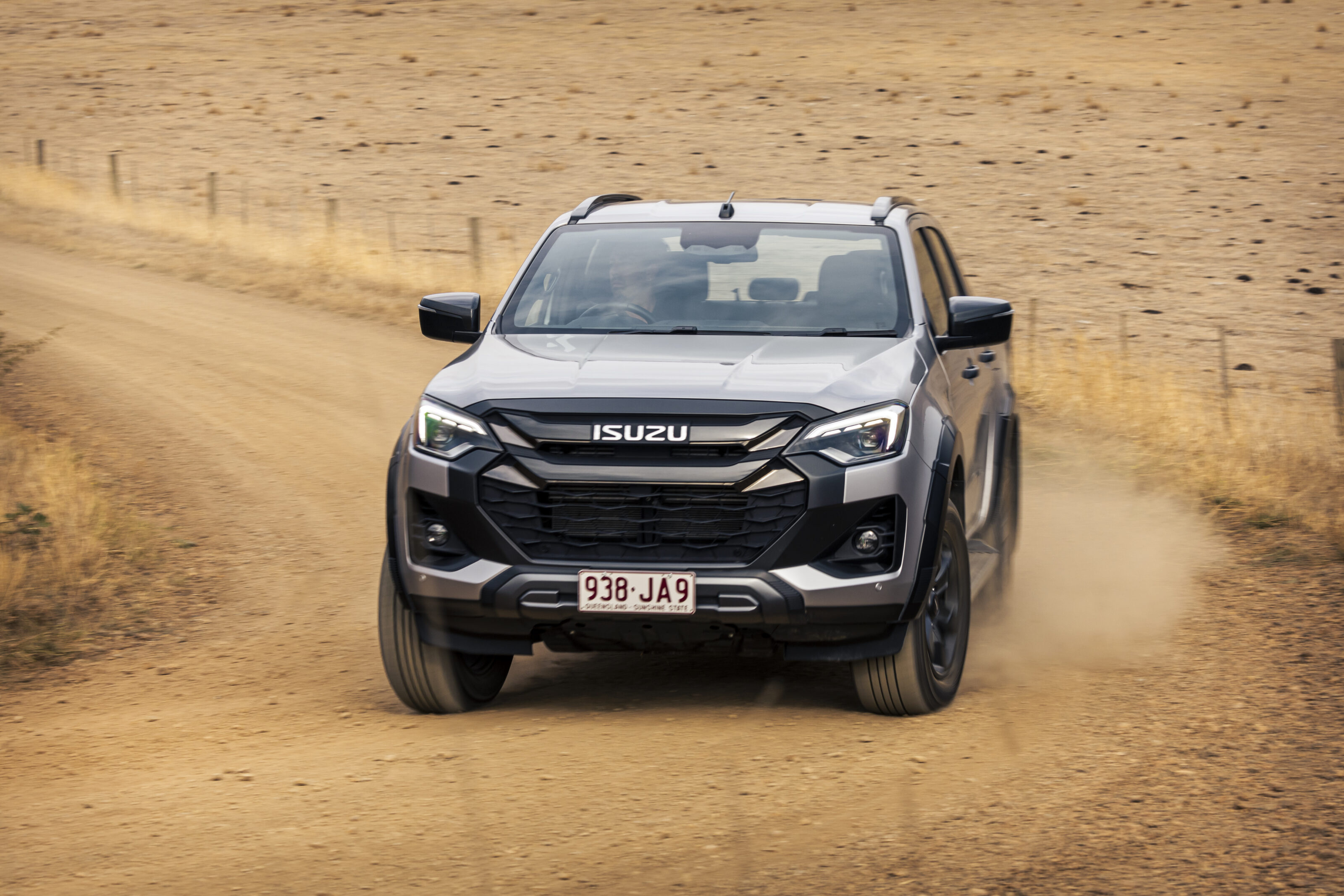
That same update has now arrived for Mazda’s BT-50, the catalyst for today’s test and looking the freshest vehicle here in its new Red Earth Metallic. The BT-50, of course, is to D-Max what Amarok is to Ranger – but on another level again. While the BT-50 was once twinned with the Ranger, these days it’s built by Isuzu for Mazda, an identical twin to the D-Max – just with a different haircut. As well as a fresh new face with CX-5-like headlights and grille, the BT-50 gets three new colours, a new infotainment system and additional safety equipment such as stop-and-go traffic jam assistance, rear cross-traffic alert with braking, and updated autonomous emergency braking that can now detect motorcycles.
It’s an update that couldn’t come soon enough. At 15,164 sales for 2024, the BT-50 was getting lapped in the proverbial sales race by the other utes here and was not even in the top 20 new car sales for 2024.
While SUVs are the focus for the brand that brought us generations of rotary-powered sports cars, the BT-50 remains just as important to Mazda Australia – especially as it hopes to eclipse the 100,000 local sales mark yet again.

In today’s four-ute shootout, we’ve set a target retail figure around the reasonable mid-range of $66,000 (before on-roads) and grabbed the grades around this price. In the Ranger’s case, that’s the $66,140 Sport – with a twin-turbo 2.0-litre turbodiesel four-cylinder mated to a 10-speed automatic. (Ford mistakenly supplied this test with an XLT with the same powertrain and a bit less equipment; from a value perspective, we will pretend it’s a Sport.)
For the HiLux, we’ve got the $63,260 SR5 and added the $2500 Premium Interior for a retail price of $65,760. The Premium Interior adds a power-adjustable driver’s seat, front seat heaters and leather-accented seat trim.
From Isuzu, we wanted the $65,500 D-Max LS-U+ but got the $70,500 X-Terrain instead. While the X-Terrain adds minor equipment like front parking sensors, they’re more or less the same. In our on-paper value analysis, we’ll be looking at the LS-U+.
Mazda meanwhile supplied the $66,170 BT-50 GT which basically matches the standard equipment of the equivalently priced D-Max LS-U+, Ranger Sport and HiLux SR5 with Premium Interior. That means at least a power-adjustable driver’s seat, leather appointed upholstery, 18-inch wheels and dual-zone climate, as well as Apple CarPlay and Android Auto connectivity.
They all cost about the same and give you about the same standard equipment – no huge outliers here. But what the brochures and spec sheets don’t give you is how you feel sitting in each vehicle. And boy, are they different.
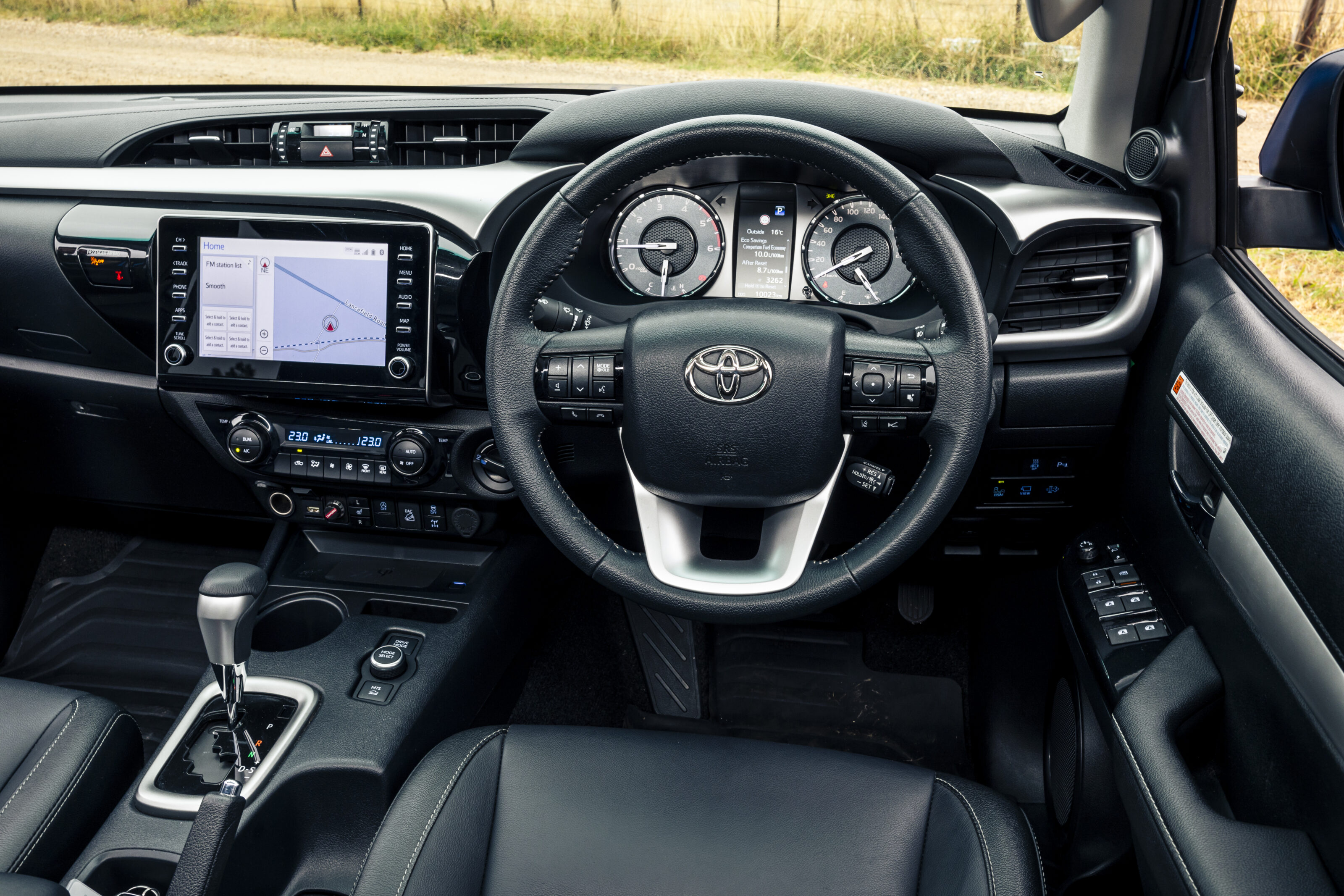
Getting into the HiLux is like going back to when Barack Obama was US President, Malcolm Turnbull had just knifed Tony Abbott for the Australian prime ministership and COVID-19 did not exist (i.e. a much simpler time).
With fundamentally the same dashboard design from 2015, the HiLux feels ancient inside compared with the other vehicles here; Toyota has taken the ‘if it ain’t broke, don’t fix it’ philosophy to new levels. We’re sure the digital dashboard clock, with buttons for ‘H’ and ‘M’, will still be keeping time long after the earth has been absorbed into the sun, but in 2025 it couldn’t date a new car’s interior more. Same for the old cruise control stalk which looks 20 years old.
Toyota has at least tried with the fitment of a wireless phone charger, but pairing it with wired Apple CarPlay for its small 8.0-inch infotainment screen seems silly. How hard is it to offer wireless phone connectivity? There are a million aftermarket replacement infotainment systems with wireless CarPlay capability on eBay, and for not much.
And if a Chinese-made vehicle had the same resolution of the HiLux’s reversing camera, we’d be giving it a right bollocking.
The Premium Interior does add some niceties, but the steering wheel looks like leather, feels like urethane. Cheap, in other words.
At the very least, the HiLux interior is comfortable enough, everything works well and there’s no wondering if it’ll all still work in 10 years. Or 20, or 30, for that matter. It will probably still look brand new. And at least the HiLux gives you one-touch electric windows on each corner – you can’t say the same about the D-Max and BT-50 which reserve that for the driver only. Little things like this count.
Jumping from the HiLux to the Isuzu D-Max, however, is like you’ve just driven your old car down to a new car dealership to check out the latest car interior from 2025.
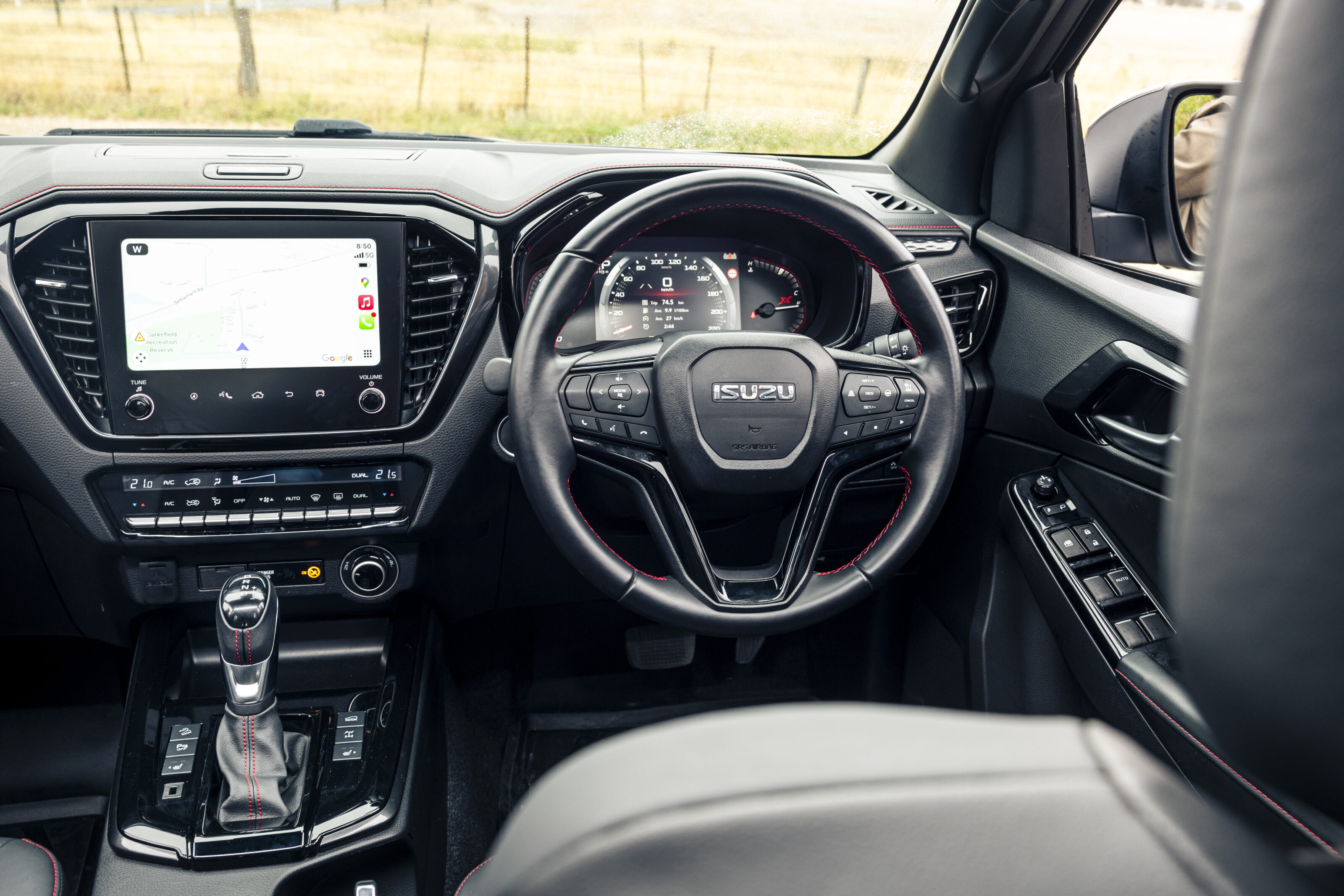
While our test car is the pricier X-Terrain with a flash interior including red stitching, all D-Max interiors have the same pleasing, contemporary straight dashboard lines and from LS-U grades and up, a lovely, crisp 9.0-inch infotainment display (with wireless CarPlay and Android Auto). Unlike the HiLux’s screen, which looks retrofitted into its dash, the D-Max screen is much better integrated. The slim row of heating and cooling controls also looks much nicer and smarter. You don’t get a wireless phone charger but you do get a 7.0-inch digital instrument cluster display (nestled between some analogue items), just another element which helps make the D-Max’s interior feel like it’s for the modern age.
Blindfold someone and shift them from the D-Max into the BT-50 and if it wasn’t for the dirty-big Mazda badge on the steering wheel, they’d simply think they’d slipped into another D-Max. That’s not necessarily a bad thing.
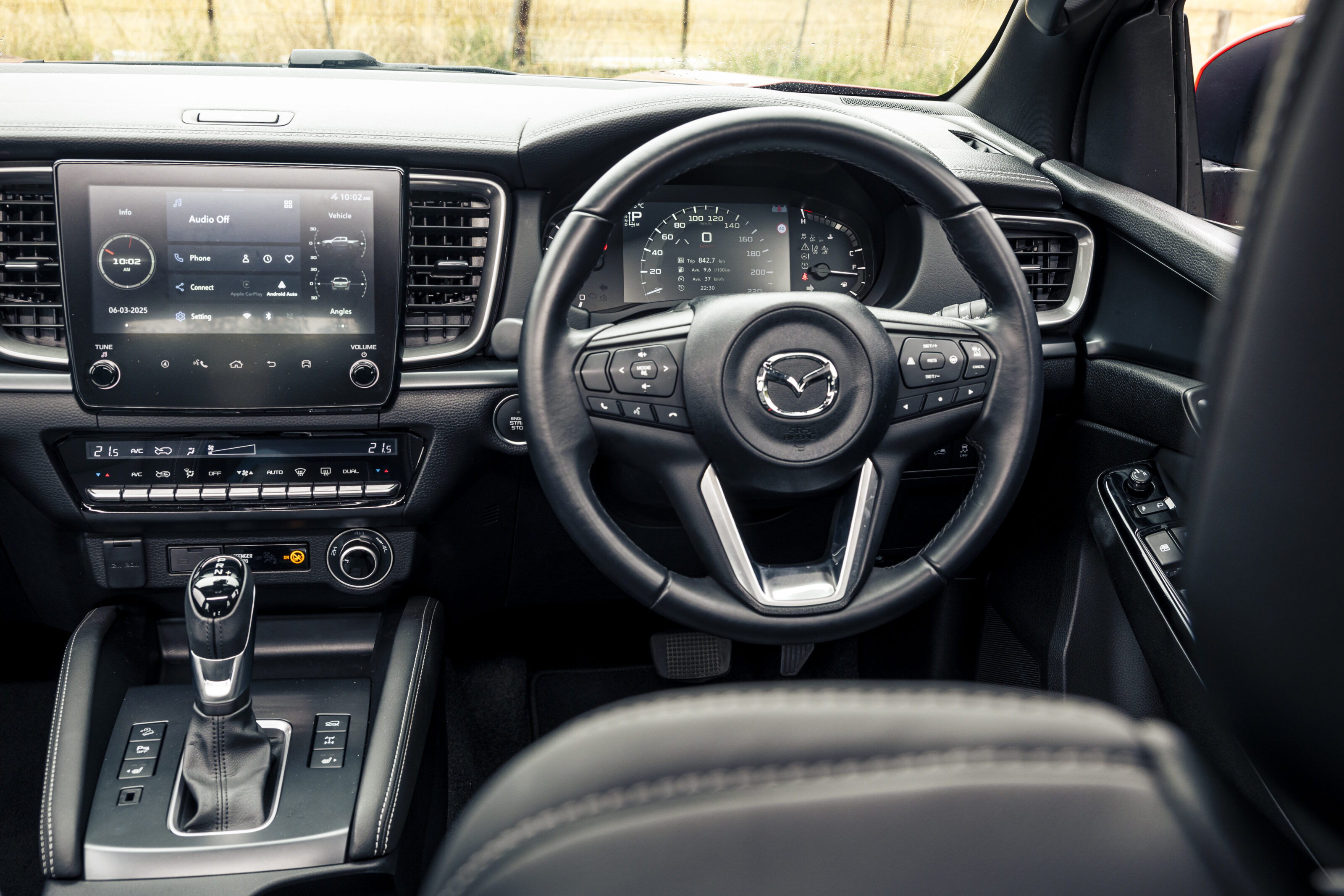
While the steering wheel and some of the button fonts are the same, the Mazda’s infotainment and digital dashboard benefit from more grown-up font choices and general display graphics. That alone makes the BT-50’s interior feel like it’s for a 40-year-old, not a 25-year-old in the case of the D-Max. (Although a lot of that could be its just-downed-a-can-of-Monster, X-Terrain interior styling.)
None of these utes, however, feel as modern as the Ranger, whose fundamental interior layout and design feels a generation newer.
It’s the only vehicle with an electric park brake, while gone are the analogue dials of the other vehicles; in its place a smart, standard 8.0-inch digital instrument cluster with a no-frills vibe. The 10.1-inch portrait infotainment touchscreen also dwarfs that of the other vehicles, and gives it the most contemporary feeling interior here. It feels like the ute you buy when you’re finally all grown up.
The Ranger also has the best driving position – the most SUV-like – placing you tennis-umpire-high but in proportional perfection relative to the steering wheel and pedals (as close as you could hope in a dual-cab, anyway). Like slipping into a sports car with a thoughtful driving position, this sets up certain expectations for how it might drive.
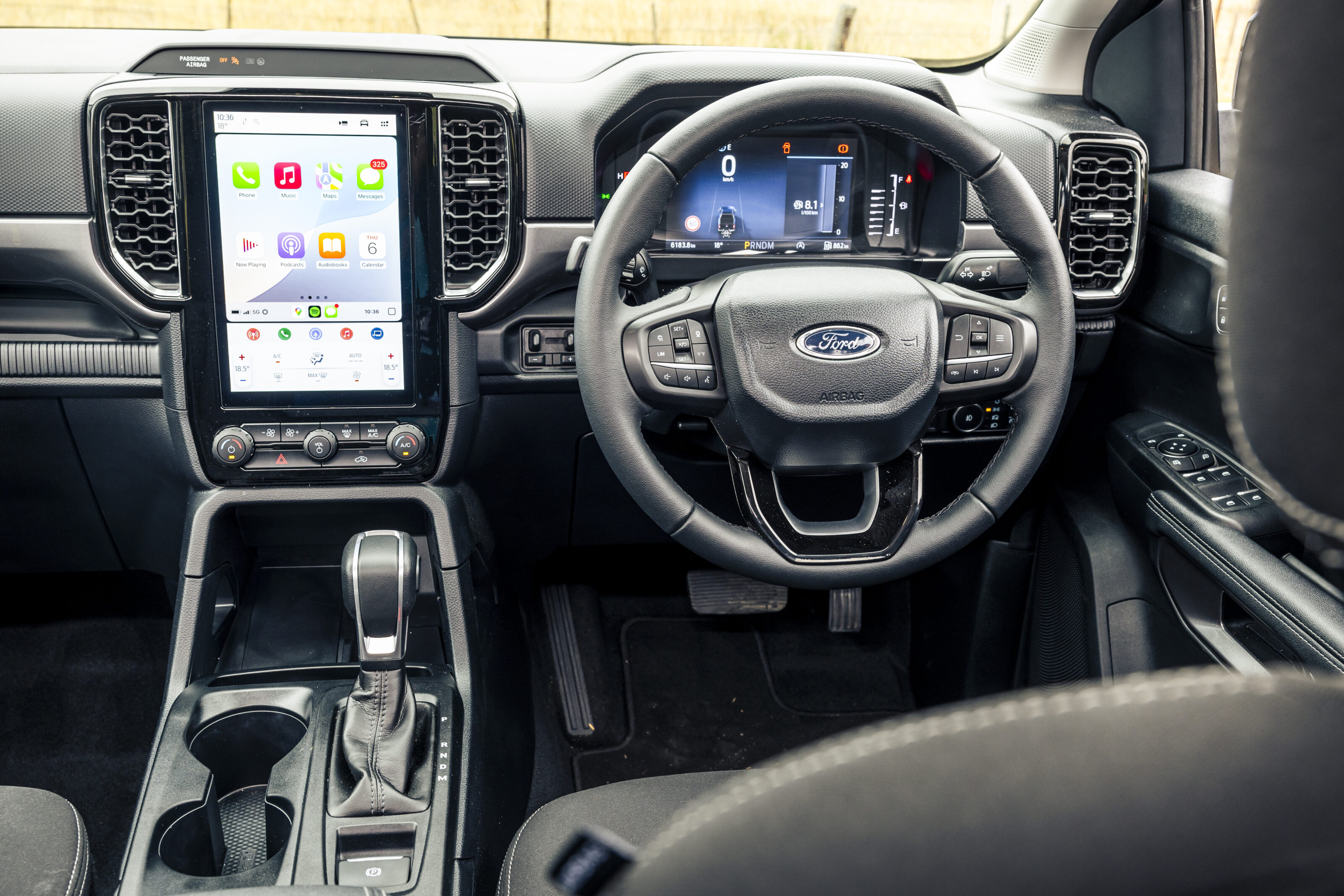
That bit starts in the urban surrounds of Melbourne where, for all their four-wheel-drive with high- and low-range, 3.5-tonne towing capacities and circa-one-tonne payloads, this is most likely to be
the real natural habitat of these vehicles, for better or worse.
From the outset, the Ranger is simply pleasant to drive. Despite its size, light steering makes it reasonably manoeuvrable at low speeds while the 10-speed auto does a terrific job of keeping the 2.0-litre engine in its torque sweet spot at all times. This engine packs 154kW and 500Nm (from 1750rpm), which is more than enough to hustle along a portly 2296kg of ute in traffic.
In fact, the 10-speed auto is so smooth and adept at keeping you in the middle of that vein of turbodiesel torque, it’s almost like a CVT – but with lots of lovely little gears, and no soul-sapping sensation of a constantly variable ratio.
While it’s still obviously a ladder-frame vehicle with a live rear axle, the Ranger drives with a maturity we’ve rarely felt from a vehicle of this configuration. The ride quality is decent enough that you’re not tempted to carry a tonne in the tray as simple ballast; while the steering has a car-like directness to it, even in the city.
It’s a hard act to follow, and next up is the Toyota.
Anyone who’s driven a HiLux in the last 10 years will find the Toyota familiar, beginning with its heavy hydraulic steering. That makes it more of an effort in car parks, but once you’re underway it’s no concern, contributing to an easy, relaxed driving experience.

Toyota has also done a decent job with the ride quality – while there’s an unladen firmness to the rear-end, there’s the sense the damping has been polished over many years to offer something at least half-comfortable.
With 150kW and a fat 500Nm (from 1600rpm), the HiLux also puts plenty of turbodiesel muscularity under your right foot – including, presumably, a bit of electric motor assistance at times. That bit is harder to tell, but what is most impressive is the HiLux’s laser-fast start-stop system which might just be the best example of this setup we’ve experienced in any car. No joke; you’ll want to leave it on just to admire how good it is.
Jump from the HiLux into the D-Max or BT-50 and immediately both those vehicles feel like they’re working a little bit harder at all times. The engines are louder and the progress doesn’t feel quite as effortless. With lower outputs of 140kW, and 450Nm (from 1600rpm), it’s as if Mazda and Isuzu have tried to compensate with more aggressive throttle maps.
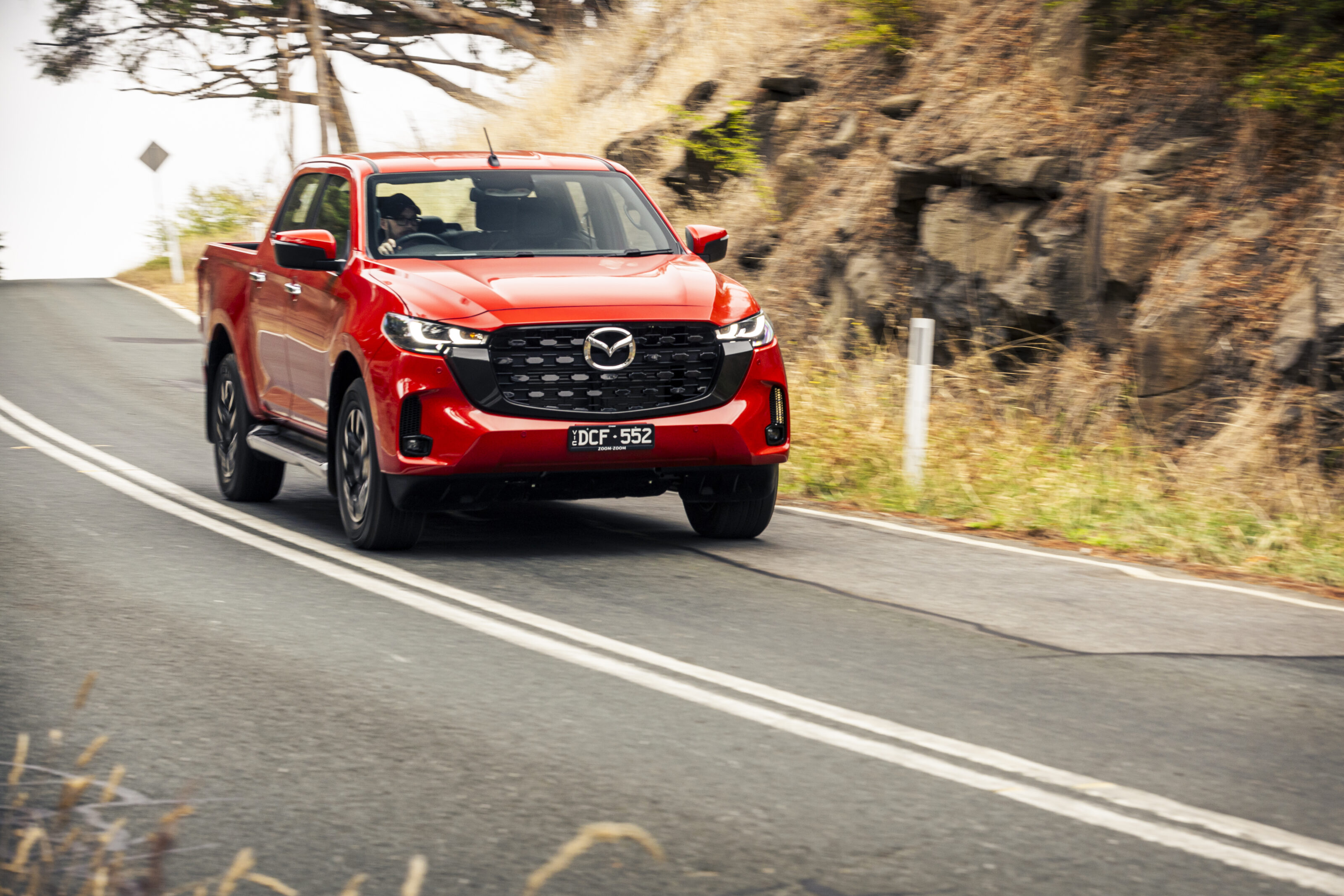
Compared to the old-school, heavy hydraulic steering of the HiLux, however, both Mazda and Isuzu offer breezily light electrically-assisted steering at reduced speeds, making them just that little bit easier to drive at the lowest of speeds. That’s even if they don’t ride quite as well as the Ford or Toyota, bumping around with a bit more leaf-sprung aloofness.
For the varying outputs, weights and number of gears, however, a very unscientific test revealed that of all four vehicles here, the HiLux, D-Max and BT-50 are about level-pegged from zero to 100km/h, with the Ranger just a little bit quicker. And once you’ve reached triple figures, as we experienced on the open, country-like roads north of Melbourne towards Lancefield, it’s the Ranger you’ll want to be in. By a long way.
Where the other utes bounce about, jiggle through their ladder frames and experience bump-steer over the biggest bumps and road cambers, the Ranger is most unperturbed on an Aussie 100km/h country road. The other utes feel they need constant steering supervision as the road surface shifts and changes, but the Ranger’s steering tracks straight and confidently across road impurities in such a way that would make long country trips much easier.
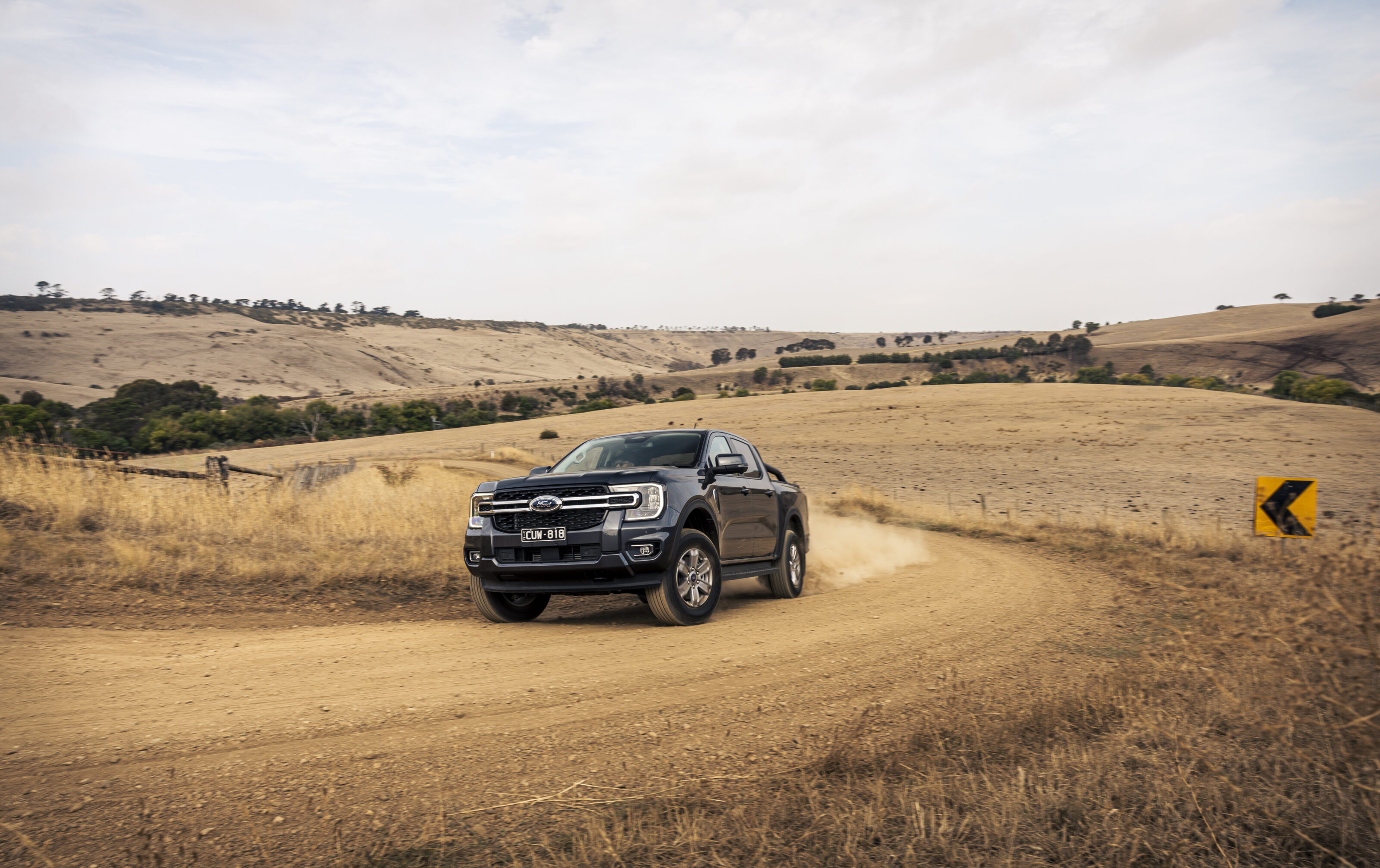
Even on some winding bitumen roads, the Ranger showed off steering and dynamics that, while not going to win any Performance Car of the Year awards, offered at least some semblance of driver engagement. You might almost have fun in the Ranger on a twisty road, whereas the other utes would simply tire you out. A Raptor version of a HiLux, D-Max or BT-50 would simply not work, but drive even a 2.0-litre Ranger and you can tell there’s a platform here capable of a performance variant. As is the case.
By comparison, the Toyota, Mazda and Isuzu feel heavy, awkward and unsure when punted through a bitumen corner at any speed not considered pootling. Driver appeal, they have little.
Perhaps most telling for this road-tester, personally, is that towards the end of our driving I found myself in the Ranger and uninterested in getting back in the other vehicles.
Of course, things might have been different if today’s test involved any towing or off-roading (it didn’t, save for some photography on an unsealed road). All utes here claim 3.5-tonne braked towing capacities although interestingly, it’s the Ranger that could be best set-up for towing to this weight with its generous 6350kg gross combined mass (GCM). The HiLux’s is a potentially skinny 5850kg while the Isuzu and Mazda, a more forgiving 6000kg. They are also slightly lighter vehicles.
The Ranger also has the most usable tray, the most spacious back seat (just), and could be the cheapest ute here to run. The 2.0-litre bi-turbo claims 7.2L/100km but from our test, we would estimate fuel use closer to 8.2L/100km combined. Five years of servicing is $2550.
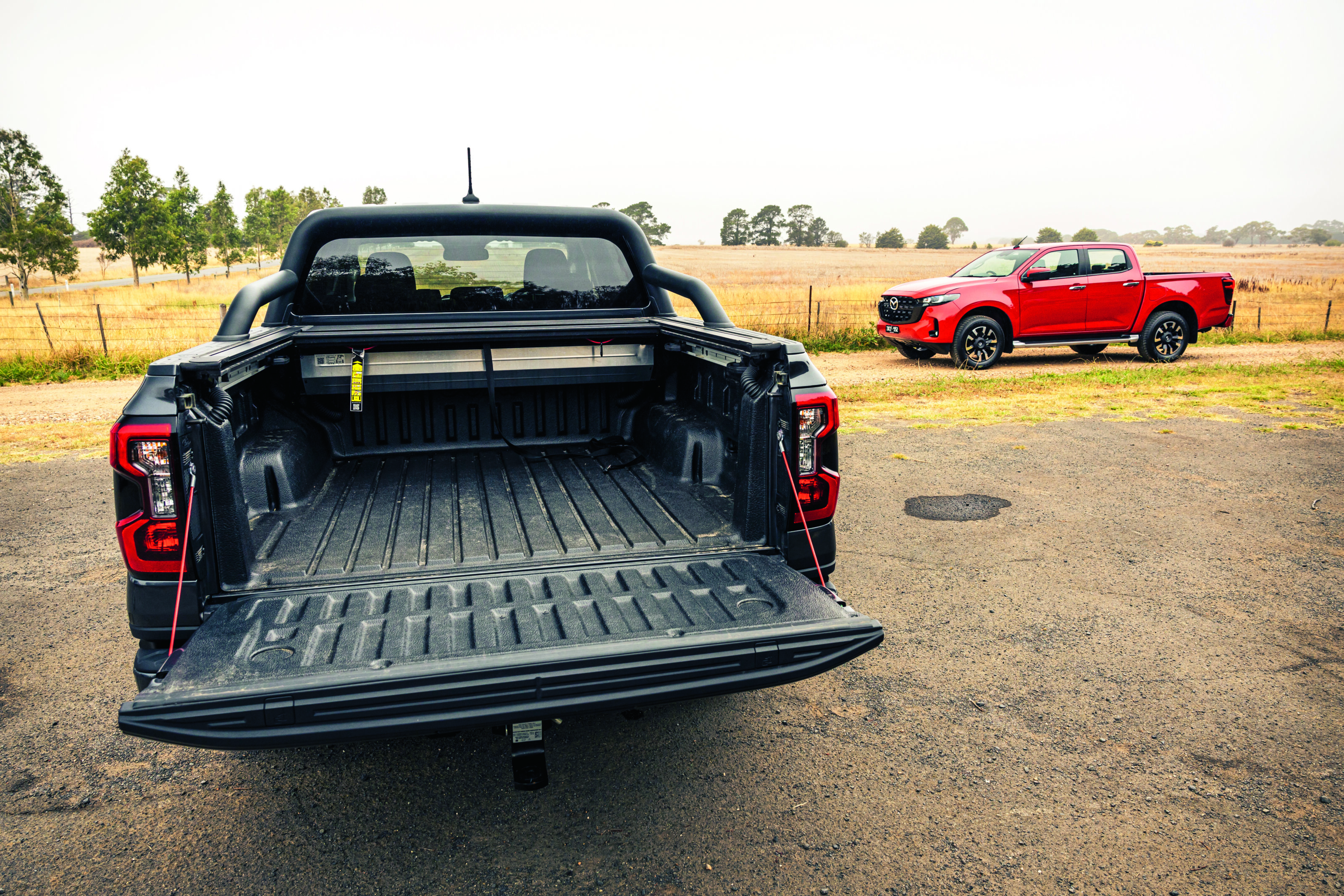

Our Mazda test vehicle was recording around 9.5L/100km, and the Isuzu 8.7L/100km, but we’d attribute this to a ghost in the system somewhere. Both claim 8.0L/100km and both could be expected to use the same amount of fuel in the real world. At $2345, the Isuzu is slightly cheaper to service over five years than the Mazda, which is $2498.
While the Ford, Mazda and Isuzu all have reasonably standard 15,000km/12 month service intervals, you’ll want to live close to a Toyota dealership with HiLux ownership, given the brand stipulates servicing every 20,000km or, somewhat annoyingly, six months. That means after five years, you’ll have visited a Toyota dealership twice as often as the other vehicles here. And at an eyebrow-raising cost of $3985.
For fuel efficiency, it seems Toyota should have fitted a 10-speed transmission before it bothered with the 48-volt system given you could be expected to use around 8.7L/100km in the real world. Toyota claims 7.2L/100km.
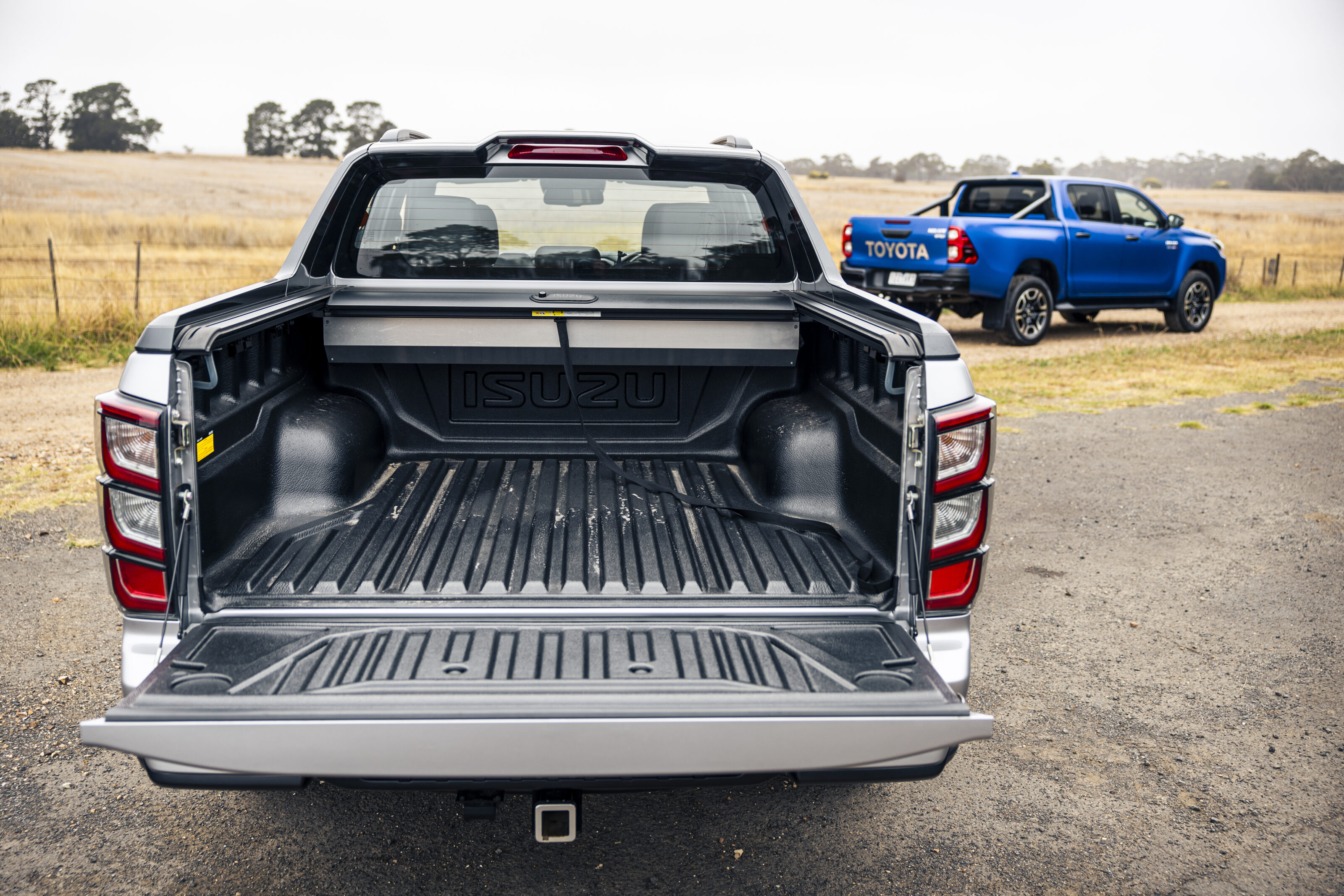

In the final reckoning, then, it’s perhaps unsurprising to see the Toyota HiLux cruise home in fourth place. While it remains a stalwart of the dual-cab ute world, only improved by the new 48-volt system, the HiLux’s interior hasn’t fundamentally changed in 10 years. Even with the optional Premium Interior, it just feels very last decade.
A new HiLux, due next year with presumably a totally new interior, is overdue.
It’s also pricey to service and hasn’t been crash-tested by ANCAP since 2019 (the others were tested in 2022).
This is still the ute you’d get if you wanted to buy a new vehicle and never have to replace it. It feels built to do a million kilometres. If you don’t care for the new 48-volt system, you may as well just buy a second-hand one. A new car warranty is worth little on a HiLux.
Third place goes to the Mazda BT-50. While it’s the freshest-feeling vehicle here – and we think the prettiest – it’s just a smidge pricier than the Isuzu ($670 more), a little bit more expensive to service ($153 more) and for most people, Isuzu’s six-year, 150,000km warranty will trump Mazda’s five-year, unlimited kilometre warranty.
The honest D-Max gets second place in this test, but depending on your personal circumstances it could easily swap finishing positions with the Mazda. If you were interested in either of these utes, and weren’t fussed by the styling differences, go to each dealer and ask for the best deal. That just might determine this bout of quasi-sibling rivalry in your own individual case.

That leaves, of course, the Ford Ranger.
If the HiLux just feels like an older vehicle, the BT-50 and D-Max at least feel like vehicles with modern exteriors and interiors (if old underneath). The Ranger, however, combines a modern exterior and interior with modern engineering.
The T6.2 is so much more mature a vehicle to drive than the others here, that this would have been a fairer test using the last-generation Ranger. Its interior feels fundamentally newer, we love the 10-speed auto and it drives in an almost SUV-like way that makes the HiLux, D-Max and BT-50 feel like light commercial vehicles.
Not just in sales, but in the way it drives, particularly in Australian conditions, the Ranger keeps the number “1” loud and proud on its door today.

